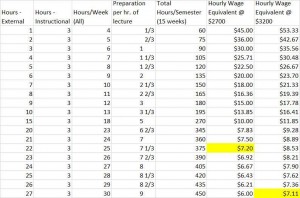A few months back I ran a few basic calculations that refuted the myth of the “minimum wage adjunct” by showing that an adjunct faculty member would have to spend an absurdly high number of hours on out-of-class preparation time and grading to even approach an hourly equivalent wage that fell below the minimum wage. I revisited this issue while conducting research for a forthcoming article on the academic job market, and decided to map out a full range of adjunct wage scenarios. The following chart presents the hourly wage equivalents for two different adjunct pay grades – $2,700 per course, which is the median adjunct pay for all U.S. colleges and universities, and $3,200 per course, which is the median for adjuncts who hold a PhD or terminal doctorate.
The current federal minimum wage point ($7.25) is highlighted in yellow. Note that a moderately efficient adjunct could actual make as much as $30-35 per hour by simply maintaining a ratio of 1 hour in external preparation for every 1 hour spent in the classroom. And even a moderately inefficient teacher who spent 3 hours preparing for every 1 hour of lecture would still pull in about twice the minimum wage. In short, the “minimum wage adjunct” remains a myth, even at two very typical pay variations, unless one devotes an absurdly high number of hours to teaching, preparation, and grading. An adjunct would have to spend more than 20 hours a week per class in addition to instructional time to even approach minimum wage levels for a typical 3 credit hour, 15 week course. This translates into 7 or more hours of preparation for every hour spent lecturing. Such persons – if they even exist – are so far beyond the point of diminishing returns that one might legitimately question their aptitude to teach at the university level. Or really any level.
